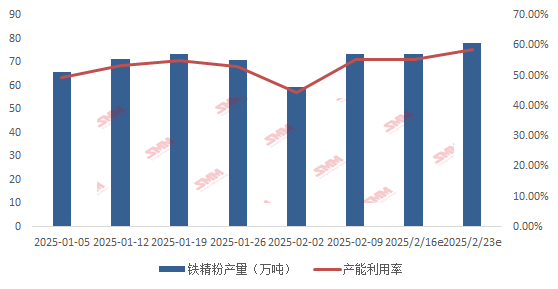






The Chinese New Year in 2025 came earlier than usual. Most domestic iron ore mines are located in northern and inland regions, where low winter temperatures combined with the traditional holiday shutdown make the period around the Chinese New Year a production low point for the year. In some regions, the production of iron ore concentrates at mines has declined, as tracked in the chart below:
Image 1: Production and Capacity Utilisation Rate of Iron Ore Concentrates at Major Domestic Mines

Data Source: SMM sample of 37 domestic mines
According to SMM data, the weekly capacity utilisation rate of the 37 major domestic mines after the Chinese New Year was 44.43%, down 8.62 percentage points compared to the pre-holiday period. Iron ore concentrate production was 593,000 mt, a WoW decrease of 115,000 mt. However, as shown in the chart above, iron ore concentrate production is expected to return to normal after the holiday. During the holiday period, the most significant declines were observed in Liaoning, Hebei, Shandong, and Xinjiang. Overall, while there was a dip in domestic iron ore concentrate production during the holiday, its impact on overall production in the later period is expected to be limited.
The reasons for the production decline are as follows:
1. The Chinese New Year in 2025 occurred earlier, and workers may have returned to their hometowns as early as mid-January, leading to a labor shortage at mines earlier than usual. This caused short-term production halts at some mining and beneficiation plants.
2. In some regions with lower temperatures, there is a tradition of winter breaks. For example, in parts of Xinjiang and Liaoning, some mines and beneficiation plants reported halting production after late January, with production expected to gradually resume by the end of February.
3. During the Chinese New Year period, domestic iron ore concentrate prices were relatively low, leading to a cautious sentiment among mines and beneficiation plants and generally weaker production enthusiasm.
Feedback from some mines:
Shandong Mine A: Production was halted during the holiday period from Chinese New Year's Eve to the fifth day of the lunar new year. As a state-owned enterprise, we observe the holiday as required.
Liaoning Mine B: We stopped production starting from the 26th day of the twelfth lunar month and expect to resume production only after the Two Sessions. Local shipments are also slow.
Hebei Mine C: We will take a break for about three days during the holiday, with minimal impact on overall iron ore concentrate production.
Hebei Mine D: We will not halt production during the holiday. Workers will rotate in three shifts, and as long as we are not losing money, we will continue production.
Xinjiang Mine E: Some mines in Xinjiang are still operating normally, but many large mines in the region have halted production for the holiday. Production is expected to gradually resume around early March.
For queries, please contact William Gu at williamgu@smm.cn
For more information on how to access our research reports, please email service.en@smm.cn